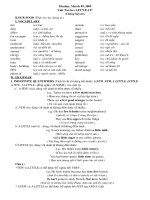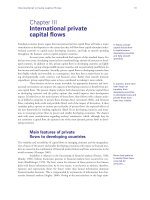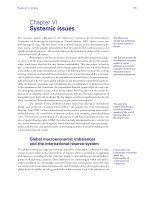FOOD RESOURCES
Bạn đang xem bản rút gọn của tài liệu. Xem và tải ngay bản đầy đủ của tài liệu tại đây (197.99 KB, 19 trang )
FOOD
RESOURCES
FOOD RESOURSES
World food problems,
Changes caused by agriculture
and over-grazing,
Effects of modern agriculture,
Fertilizer-pesticide problems,
Water logging, salinity.
FOOD
Food is any substance, usually composed
of carbohydrates, fats, proteins and water, that can
be eaten or drunk by an animal, including humans,
for nutrition.
Human nutritional requirements :
Carbohydrates and lipids for energy (calories)
Proteins from body structure (humans cannot make 8
essential amino acids and so need them in their diet)
Minerals - inorganic elements such as iron and calcium
that are essential for the normal functioning of the body
Vitamins - complex organic molecules that are required in
very small amounts by living cells
Food Resources
The main food resources –
Crop plants-wheat, rice, maize, barley, oats,
pulses, sugarcane, other fruits and vegetables,
(76% of total foodgrain)
Range lands- meat & milk from grazing livestock
(17% of total food)
Fisheries (7%)
The FAO estimation – minimum calorific
intake on a global scale is 2,500 calories/day.
Undernourished - < 90% of min
requirement
seriously under nourished - < 80%
Deficiency or lack of nutrition malnutrition
World Food Problems
Last 50 years
world grain production increased three times
increase in per capita production by
about 50%
population growth (mostly in less developed
countries)
Every year 40 million people die of under
nourishment and malnutrition
INDIAN SCENARIO
3rd largest producer of staple crops
300 million Indians are under nourished
Overgrazing
Livestock wealth plays a crucial role in the rural
life of our country
India leads in livestock population
The huge population of live stock needs to be
fed and the grazing land or the pastures areas
are not adequate
Livestock grazing on a particular piece of grass
land or pasture surpass the carry capacity
Carrying capacity of any system is the
maximum population that can be supported by it
on a sustainable basis
However, most often, the grazing pressure is so
high that its carrying capacity is crossed and the
sustainability of the grazing land fails
Impacts of Overgrazing
Land Degradation
Overgrazing removes the vegetal cover over the soil
and the exposed soil gets compacted due to which the
operative soil depth declines
• Roots cannot go deep into the soil
• Adequate soil moisture is not available
Organic recycling also declines in the ecosystem
Because → not enough detritus or litter remains on the soil to be
decomposed
The humus content of the soil decreases and
overgrazing leads to organically poor, dry, compacted
soil
Due trampling by cattle the soil loses infiltration
capacity, which reduces percolation of water into the
soil and as a result of this more water gets lost from the
ecosystem along with surface runoff
Thus overgrazing leads to multiple actions
resulting in loss of soil structure, hydraulic
conductivity and soil fertility
Impacts of Overgrazing
Soil
Erosion
Due to overgrazing by cattle, the cover of vegetation
almost gets removed from the land
The soil becomes exposed and gets eroded by the action
of strong wind, rainfall etc…
The grass roots are very good binders of soil
When the grasses are removed, the soil becomes loose
and susceptible to the action of wind and water
Loss of useful species
Overgrazing adversely affects the composition of
plant population and their regeneration capacity
The original grassland consists of good quality
grasses and forbs with high nutritive value
Heavy grazing – root stocks which carry the reserve
food for regeneration gets destroyed
Replacement by secondary species
The secondary species are hardier and are less
nutritive in nature
Ultimately the nutritious, juicy fodder giving species
like Cenchrus, Dicanthium, Pancium and Heteropogon
etc… are replaced by unpalatable and sometimes thorny
plants like Parthenium, Lantana, Xanthium etc…These
species do not have a good capacity of binding the soil
particles and, therefore, the soil becomes more prone
to soil erosion
Thus overgrazing makes the grazing land lose its
regeneration capacity and once good quality
pasture land gets converted into an ecosystem with
poor quality thorny vegetation
Agriculture
Slash and burn cultivation or shifting
cultivation
Modern agriculture
The types of agriculture are very different in their
process and their outputs in terms of yield as well as
their impacts on the environment
Traditional Agriculture and its Impacts
It
usually involves a small plot, simple tools,
naturally available water, organic fertilizers and a
mix of crops
It is more near to natural conditions and usually
it results in low production
The main Impacts of this type of agriculture are
Deforestation
The slash and burn of trees in forests to clear the land for
cultivation and frequent shifting results in loss of forest cover
Soil Erosion
Clearing of forest cover exposes the soil to wind, rain and
storms, thereby resulting in loss of top fertile layer of soil
Depletion of Nutrients
During slash and burn the organic matter in the soil gets
destroyed and most of the nutrients are taken up by the crops
within the short period, thus making the soil nutrient poor which
makes the cultivator to shift to new area
Modern Agriculture and its
Impacts
It
makes use of hybrid seeds of selected single
crop variety, high-tech equipments and lots of
energy subsidies in the form of fertilizers,
pesticides and irrigation water
The food production has increased tremendously,
evidenced by the “green revolution”
The Impacts
Impacts related to high yielding varieties
Fertilizer related problems
Pesticide related problems
Water logging
Salinity problems
Impacts related to high yielding
varieties
The
use f high yielding varieties encourage
monoculture
In case of an attack by some pathogen, there is
total devastation of the crop by the disease due to
exactly uniform conditions, which help in rapid
spread of disease
Fertilizer
related problems
Micronutrient Imbalance
Most of the chemical fertilizers used in modern agriculture
have nitrogen, phosphorus and potassium which are essential
macronutrients
Farmers use these indiscriminately to boost up crop growth.
Nitrate Pollution
Nitrogenous fertilizers applied in the fields often leach deep
into soil and ultimately contaminate the ground water
The nitrates get concentrated in the water and when their
concentration exceeds 25 mg/L, they become the cause of a
serious health hazard called “Blue Baby syndrome”
Eutrophication
Eutrophication means Over Nourishment
Due to eutrophication lakes get invaded by algal blooms; these
algae grows very fast by rapidly using up the nutrients, they
often are toxic and badly affect the food chain
Pesticide related problems
Creating
resistance in pests and producing new
pests
Some individuals of the pest species usually survive
even after pesticide spray
The survivors give rise to highly resistant
generations
About 20 species of pests are now known which
have become immune to all types of pesticides an
are known as “super pests”
Death of non-target organisms
Many insecticides are broad spectrum poisons which
not only kill the target species but also several
non-target species which are useful to us
Biological magnification
Many of the pesticides are not biodegradable and
keep on accumulating in the food chain, this
process is called as biomagnification
Water logging
Over
irrigation of croplands by farmers for
good growth of their crop usually leads to water
logging
Inadequate drainage causes excess water to
accumulate underground and gradually forms a
continuous column with the water table
Under water logged cond itions, pore spaces
in the soil get fully drenched with water and the
soil-air gets depleted
The water table rises while the roots of the
plant do not get adequate air for respiration
Mechanical strengt h of the soil declines, crop
plants get lodged and crop yield fails
Preventing excessive irrigation , sub-surface
drainage technology and bio-drainage with trees
like Eucalyptus are some of the remedial
measures to prevent water logging
Salinity Problems
At
present ⅓rd of the total cultivable land area of
the world is affected by salts
In India about 7 million Hectares of land are
estimated to be salt affected
Saline soils are characterized by the accumulation
of soluble salts like sodium chloride, sodium
sulphate, calcium chloride, magnesium chloride…
The most common method for getting rid of salts is
to flush them out by applying more good quality
water to such soils. Another method is laying under
ground network of perforated drainage pipes for
flushing out the salts slowly









